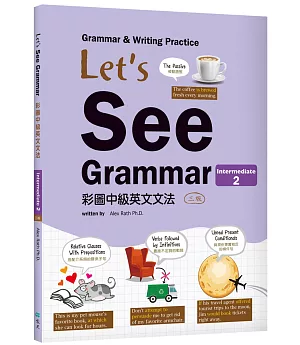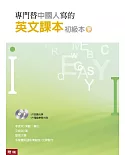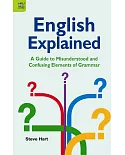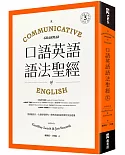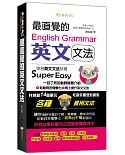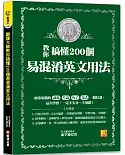Part 12 Modal Verbs (1) 情態動詞(1)
Unit 90 Modal Verbs: General Use (1) 情態動詞的一般用法(1)
Unit 91 Modal Verbs: General Use (2) 情態動詞的一般用法(2)
Unit 92 Ability: Can, Be Able To 表示「能力」:Can、Be Able To
Unit 93 Ability: Could, Be Able To 表示「能力」:Could、Be Able To
Unit 94 Permission: Can, Could, May 表示「許可」:Can、Could、May
Unit 95 Obligation and Necessity: Must, Have To 表示「義務與必要」:Must、Have To
Unit 96 Obligation and Necessity: Have to, Have Got to表示「義務與必要」:Have To、Have Got To
Unit 97 Obligation and Choices: Mustn't, Don't Have To, Haven't Got To, Don't Need To, Needn't, Didn't Need To 表示「義務與選擇」:Mustn’t、Don’t Have To、Haven’t Got To、Don’t Need To、Needn’t、Didn't
Need To
Unit 98 Obligation and Advice: Should, Ought To, Shall表示「義務與建議」:Should、Ought To、Shall
Unit 99 Obligation and Advice: Had Better, Be Supposed To表示「義務與建議」:Had Better、Be Supposed To
Part 13 Modal Verbs (2) 情態動詞(2)
Unit 100 Possibility: May, Might, Could 表示「可能性」:May、Might、Could
Unit 101 Possibility: Can, Should, Ought To 表示「可能性」:Can、Should、Ought To
Unit 102 Deduction: Must, Can’t 表示「推論」:Must、Can’t
Unit 103 Requests: Can, Could, May, Will, Would表示「要求」:Can、Could、May、Will、Would
Unit 104 Offers: Will, Shall, Can, Could, Would表示「提供幫助或物品」:Will、Shall、Can、Could、Would
Unit 105 Suggestions: Shall, Let’s, Why Don’t We, How About, What About, Can, Could 表示「建議」:Shall、Let’s、Why Don’t We、How About、What About、Can、Could
Unit 106 Habits: Used To 表示「習慣」:Used To
Unit 107 Habits: Will, Would 表示「習慣」:Will、Would
Unit 108 Other Uses of “Will,” “Won't,” and “Wouldn't” Will、Won’t、Wouldn’t的其他用法
Unit 109 “Would Rather” and “May/Might As Well”
Would Rather與May/Might As Well的用法
Unit 110 Important Uses of “Should” Should的重要用法
Part 14 Adjectives 形容詞
Unit 111 Form, Position, and Order of Adjectives 形容詞的形式、位置與順序
Unit 112 Comparative and Superlative Adjectives: Forms 形容詞比較級與最高級的形式
Unit 113 Comparative and Superlative Adjectives: Use 形容詞比較級與最高級的用法
Part 15 Adverbs 副詞
Unit 114 Adverbs of Manner 狀態副詞/方式副詞
Unit 115 Adverbs of Time and Place 時間副詞與地方副詞
Unit 116 Adverbs of Frequency 頻率副詞
Unit 117 Adverbs of Probability 可能性副詞
Unit 118 Adverbs of Degree 程度副詞
Unit 119 Adverbs “Still,” “Yet,” and “Already” 副詞Still、Yet、Already的用法
Unit 120 Adverbs “Too” and “Enough” 副詞Too、Enough的用法
Unit 121 Adverbs “So,” “Such,” “Anymore/Longer,” and “No Longer”副詞So、Such、Anymore/Longer、No Longer的用法
Part 16 Linking Words 連接語
Unit 122 Linking Words of Time: When, As, While, As Soon As, Before, After, Until表示「時間」的連接語:When、As、While、As Soon As、Before、After、Until
Unit 123 Linking Words of Contrast: Although, Even Though, Though, However, In Spite Of, Despite, While, Whereas 表示「對比」的連接語:Although、Even Though、Though、However、In Spite
Of、Despite、While、Whereas
Unit 124 Linking Words of Reason: Because, Because Of, As, Since, Due To表示「原因」的連接語:Because、Because Of、As、Since、Due To
Unit 125 Linking Words of Result: So, As a Result, Therefore, So . . . That, Such . . . That 表示「結果」的連接語:So、As A Result、Therefore、So . . . That、Such . . . That
Unit 126 Linking Words of Purpose: To, In Order To, So As To, For, So That表示「目的」的連接語:To、In Order To、So As To、For、So That
Unit 127 Linking Words of Purpose: In Case 表示「目的」的連接語:In Case
Part 17 Prepositions of Place and Movement 表示地點與移動方向的介系詞
Unit 128 Prepositions of Place: Basic Meanings Of “In,” “At,” and “On”表示「地點」的介系詞:In、At、On的基本意義
Unit 129 Prepositions of Place: “In,” “At,” and “On” With Different Locations表示「地點」的介系詞:In、At、On說明各種地點的用法
Unit 130 Prepositions of Place: Over, Under, Above, Below, Underneath表示「地點」的介系詞:Over、Under、Above、Below、Underneath
Unit 131 Prepositions of Place: In Front Of, Behind, Between, Among, Opposite表示「地點」的介系詞:In Front Of、Behind、Between、Among、Opposite
Unit 132 Prepositions of Place: Near, Next To, By, Beside, Against, Inside, Outside表示「地點」的介系詞:Near、Next To、By、Beside、Against、Inside、Outside
Unit 133 Prepositions of Movement: In, Into, Out Of, On, Onto, Off表示「移動方向」的介系詞:In、Into、Out Of、On、Onto、Off
Unit 134 Prepositions of Movement: Up, Down, From, To, Toward表示「移動方向」的介系詞:Up、Down、From、To、Toward
Unit 135 Prepositions of Movement: Along, Across, Over, Through, Past, Around表示「移動方向」的介系詞:Along、Across、Over、Through、Past、Around
Unit 136 Transport: Get In, Get Out Of, Get On, Get Off, By, On, In表示「交通方式」的詞彙:Get In、Get Out Of、Get On、Get Off、By、On、In
Part 18 Prepositions of Time 表示時間的介系詞
Unit 137 Prepositions of Time: In, At, On (1) 表示「時間」的介系詞:In、At、On(1)
Unit 138 Prepositions of Time: In, At, On (2) 表示「時間」的介系詞:In、At、On(2)
Unit 139 Prepositions of Time: For, Since, Before (Compared With the Adverb “Ago”)表示「時間」的介系詞:For、Since、Before(與副詞Ago比較)
Unit 140 Prepositions of Time: During (Compared With “In,” “For,” and “While”)表示「時間」的介系詞:During(與In、For、While比較)
Unit 141 Prepositions of Time: By, Until, From . . . To, From . . . Until, Before, After表示「時間」的介系詞:By、Until、From . . . To、From . . . Until、Before、After
Part 19 Other Prepositions 其他介系詞
Unit 142 Individual Usage Of Prepositions: With, By, In, On一些介系詞的個別用法:With、By、In、On
Unit 143 Individual Usage of Prepositions: Like, As (Compared With “As If”)一些介系詞的個別用法:Like、As(與連接詞As If 比較)
Unit 144 Indirect Objects With or Without “To” and “For” To與For搭配間接受詞的用法
Unit 145 Adjectives With Specific Prepositions (1) 形容詞所搭配的特定介系詞(1)
Unit 146 Adjectives With Specific Prepositions (2) 形容詞所搭配的特定介系詞(2)
Unit 147 Nouns With Specific Prepositions (1) 名詞所搭配的特定介系詞(1)
Unit 148 Nouns With Specific Prepositions (2) 名詞所搭配的特定介系詞(2)
Unit 149 Verbs With Specific Prepositions 動詞所搭配的特定介系詞
Unit 150 Prepositional Phrases 慣用的介系詞片語
Unit 151 Review of Prepositions 介系詞總複習
Part 20 Types of Sentences 句子的種類
Unit 152 Yes/No Questions Yes/No疑問句
Unit 153 Wh- Questions Wh-疑問句
Unit 154 Question Words: What, Who, Which, Whose 疑問詞:What、Who、Which、Whose
Unit 155 Question Words: Where, When, Why, How 疑問詞:Where、When、Why、How
Unit 156 Negative Questions 否定疑問句
Unit 157 Tag Questions 附加問句
Unit 158 Tag Questions: Other Forms 特殊的附加問句形式
Unit 159 Reply Questions 回應式疑問句
Unit 160 Indirect Questions 間接問句
Unit 161 Short Replies With “So Do I,” “Neither Do I,” etc. So Do I、Neither Do I等簡答句型
Part 21 Passive Voice 被動語態
Unit 162 The Passive: Forms 被動語態的形式
Unit 163 The Passive: General Use 被動語態的一般用法
Unit 164 Verbs With Two Objects and the Use of “By” and “With” in the Passive雙受詞的動詞,以及By與With在被動句裡的用法
Unit 165 Some Common Passive Sentence Structures 常見的被動句型
Unit 166 Have Something Done Have Something Done的用法
Part 22 Subjunctive Mood and Conditionals 假設語氣與條件句
Unit 167 “Wish” and “If Only” Wish與If Only的用法
Unit 168 “If” Sentences: Real Present or Future Conditionals If子句:現在或未來有可能發生的真實假設
Unit 169 General Conditionals: Repeated Events or Truth表示「習慣」或「真理」的條件句
Unit 170 “If” Sentences: Unreal Present or Future Conditionals If子句:與現在或未來事實相反的條件句
Unit 171 “If” Sentences: Unreal Past Conditionals If子句:與過去事實相反的條件句
Unit 172 Conditional Clauses Without “If” 不使用If的條件子句
Unit 173 “It's Time” in Subjunctive Mood and “And/Or” in Conditionals It's Time的假設用法與And/Or表示「條件」的用法
Part 23 Reported Speech 間接引述
Unit 174 Direct and Reported Speech 直接引述與間接引述
Unit 175 Reported Speech: Verb Forms 間接引述的一般動詞時態
Unit 176 Reported Speech: Modal Verb Forms 間接引述的情態動詞時態
Unit 177 Reported Speech: Changes of Pronouns, Adjectives, and Adverbs間接引述的代名詞、形容詞與副詞的變化
Unit 178 Reported Questions 間接引述疑問句
Unit 179 Reported Speech Using the “To Infinitive” 使用不定詞的間接引述句
Part 24 Relative Clauses 關係子句
Unit 180 Restrictive and Non-Restrictive Relative Clauses「限定關係子句」與「非限定關係子句」
Unit 181 Restrictive Relative Clauses With “Who,” “Which,” and “That”以Who、Which、That引導的限定關係子句
Unit 182 Leaving out Objective Relative Pronouns in Restrictive Relative Clauses限定關係子句中受詞關係代名詞的省略
Unit 183 Restrictive Relative Clauses With “Whose,” “Where,” “When,” and “Why/That” 以Whose、Where、When、Why/That引導的限定關係子句
Unit 184 Non-restrictive Relative Clauses 非限定關係子句
Unit 185 Relative Clauses With Prepositions 搭配介系詞的關係子句

